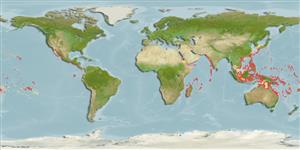>
Anguilliformes (Eels and morays) >
Ophichthidae (Snake eels) > Ophichthinae
Etymology: Brachysomophis: Greek, brachys, eia = short + Greek, soma = body + Greek, ophis = serpent (Ref. 45335); henshawi: Named for Henry W. Henshaw.
Eponymy: Henry Wetherbee Henshaw (1850–1930) was a naturalist, ornithologist and ethnologist. [...] (Ref. 128868), visit book page.
More on authors: Jordan & Snyder.
Environment: milieu / climate zone / depth range / distribution range
Écologie
marin récifal; profondeur 1 - 35 m (Ref. 42180). Tropical
Indo-Pacific.
Taille / Poids / Âge
Maturity: Lm ? range ? - ? cm
Max length : 120 cm TL mâle / non sexé; (Ref. 89972)
Vertèbres: 128 - 134. With tail 45-48% and head 13-16% of TL; dorsal fin arising well behind pectoral tips; pectoral fins fan-shaped, not elongate; snout short, about 3.4 in jaw; jaws elongate, about 2.3-3 in head; nostrils in short tubes in upper lip and closely associated; cirri of labial fringe unbranched, short and stubby; flesh above and behind eye laterally elevated as a ridge; dorsal head profile depressed and constricted behind eyes, the flesh forming a lateral eave behind dorsal margin of eye; head pores and lateral-line pores apparent; free sensory neuromasts visible as rows of white spots on nape; teeth conical; coloration in life variable; fins pale except dorsal notably dark basally with a pale margin; lateral-line pores in distinct dark spots; numerous dark spots above lateral line on body (Ref. 42180).
Found over sandy areas, usually near or within coral or rocky reefs (Ref. 42180, 75154). Feeds on fishes and crtustaceans (Ref. 89972). Benthic (Ref. 58302, 75154). At night, it is usually encountered with its head and even the anterior portion of its body protruding from the substrate at night (Ref. 42180). At day time, it often remains buried with only the tip of its snout and the top of its head projecting from the sand or mud (Ref. 42180).
Life cycle and mating behavior
Maturité | Reproduction | Frai | Œufs | Fécondité | Larves
McCosker, J.E. and J.E. Randall, 2001. Revision of the snake-eel genus Brachysomophis (Anguilliformes: Ophichthidae), with description of two new species and comments on the species of Mystriophis. Indo-Pac. Fish. (33):1-32. (Ref. 42180)
Statut dans la liste rouge de l'IUCN (Ref. 130435: Version 2024-1)
Menace pour l'homme
Harmless
Utilisations par l'homme
Pêcheries: pêcheries vivrières
Outils
Articles particuliers
Télécharger en XML
Sources Internet
Estimates based on models
Preferred temperature (Ref.
123201): 24.6 - 29.3, mean 28 °C (based on 2349 cells).
Phylogenetic diversity index (Ref.
82804): PD
50 = 0.5078 [Uniqueness, from 0.5 = low to 2.0 = high].
Bayesian length-weight: a=0.00091 (0.00039 - 0.00215), b=2.99 (2.79 - 3.19), in cm total length, based on LWR estimates for this (Sub)family-body shape (Ref.
93245).
Niveau trophique (Ref.
69278): 4.0 ±0.6 se; based on size and trophs of closest relatives
Résilience (Ref.
120179): Milieu, temps minimum de doublement de population : 1,4 à 4,4 années (Preliminary K or Fecundity.).
Fishing Vulnerability (Ref.
59153): High to very high vulnerability (72 of 100).
